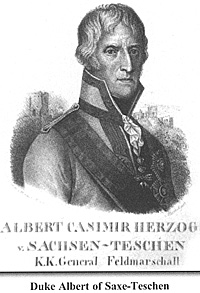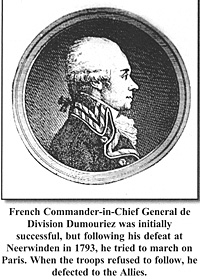Battle of Jemappes
6th November 1792
Armies Take Position
by Dave Hollins, UK
| |
Duke Albert of Saxe-Teschen The Austrians were now drawn up over a distance of 10,000 paces (about 8km) along the ridgeline of the hills running from Jemappes to Nimy, which sloped down to the Trouille stream and Haine river. On the far right, defending the village of Jemappes were 7 companies of Grün-Laudon and O’Donnell Freikorps; on the right wing under the command of FML Lilien on the hills south of Jemappes were the Morzin and Barthdeiszky Grenadier Battalions (GM Archduke Charles), two battalions of IR41 (Oberst Kaim), with three squadrons of CR 16 Blankenstein Hussars behind IR41; in the centre under FZM Clerfayt on the hill west of Cuesmes were the Leuven and Pückler Grenadier Battalions, a battalion of Würzburg infantry (GM Mikoviny), and 4 squadrons of CR37 Coburg Dragoons (GM Boros); forming the left wing under FML Beaulieu on the hills south of Bertaimont were two battalions of IR18 and one battalion of IR 17 (GM Jordis); on the far left wing around Ciply were five companies of Mihailovich (Serb) Freikorps and one squadron of CR16 Blankenstein Hussars. Between the left wing and the centre, positioned on either side of the road running to Frameries from the southern exit from Cuesmes, were eight squadrons of cavalry – four from CR37 Coburg Dragoons, two from CR31 Latour Chevauleger and two from CR32 Esterhazy Hussars – under GM Lamberg. In reserve were a battalion of IR17 at Mons and a division of IR42 was on Mont Palisel, with an additional division of IR42 and a detachment from IR15 in Mons as its garrison. The small force on Mont Palisel was intended to make the French think it was strongly garrisoned and prevent them from advancing against the left wing. Up on Mont St. Lazar a division from IR42 guarded a redoubt and the army rear, while five Jäger companies held the small wood south-east of Quaregnon, forming the forward troops on the right wing. The available troops (aside from the Mons garrison) totalled 11,628 infantry and 2, 168 cavalry. The artillery comprised fourteen 12pdrs, six 7pdr howitzers (scattered around the batteries and the redoubt) plus thirty-six 6 and 3pdr battalion guns. The terrain in front of the position was passable and clearly observable, but this position was completely commanded and overlooked from the hills around Frameries. At several points the necessary depth of the position was missing, and to the rear, the impassable swampy marshland around the two deep watercourses spread out extensively. Two raised roads ran north-west and north as lines of retreat. Certainly, there was much disquiet in the Duke’s entourage about this “most faulty and dangerous position” It was suggested that the army be withdrawn north of the Trouille and Haine; if the Duke wanted to fight south of Mons, the enemy should not be awaited but attacked immediately. These proposals were ignored - the Austrian headquarters would fatally underestimate the fighting quality of the French troops.
Dumouriez was leading a 40,000 strong force and of its 64 infantry battalions, just thirteen were Volunteers of 1792. French Commander-in-Chief General de Division Dumouriez was initially successful, but following his defeat at Neerwinden in 1793, he tried to march on Paris. When the troops refused to follow, he defected to the Allies. General Harville had a force mainly composed of about 10,000 Volunteers of 1792 to the east, so Dumouriez decided to attack Duke Albert’s force the next day. That evening of the 5th, Dumouriez had concentrated and prepared his forces for an attack: his left under GD Ferrand faced Quaregnon, the centre under Lt-General Philip Egalite (the revolutionary name adopted by the Duc de Chartres, later King Louis Phillipe) was east of Wasmes and north of Paturages; the right wind under Lt-General Bernouville was camped west of Frameries. From Harville’s corps, 6,000 men were deployed on the hills south-east of Ciply, where the rest were due to arrive during the morning of the 6th. Battle of Jemappes 6th November 1792
Armies Take Position The French Attack Long Term Effects Order of Battle: Austrian Order of Battle: French Back to Table of Contents -- First Empire # 77 Back to First Empire List of Issues Back to MagWeb Master Magazine List © Copyright 2004 by First Empire. This article appears in MagWeb.com (Magazine Web) on the Internet World Wide Web. Other articles from military history and related magazines are available at http://www.magweb.com |
 Duke Albert awaited the French along the
Cuesmes ridge to block the road to Brussels.
On 5th November, the Austrian outposts were
pushed back from just in front of Quaregnon
and pursued by the French until by that
evening, the Austrians were consolidating
their positions on the ridgeline as the fighting
died away to an exchange of heavy cannonfire.
Duke Albert awaited the French along the
Cuesmes ridge to block the road to Brussels.
On 5th November, the Austrian outposts were
pushed back from just in front of Quaregnon
and pursued by the French until by that
evening, the Austrians were consolidating
their positions on the ridgeline as the fighting
died away to an exchange of heavy cannonfire.
